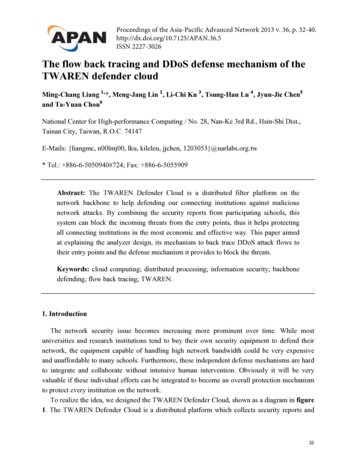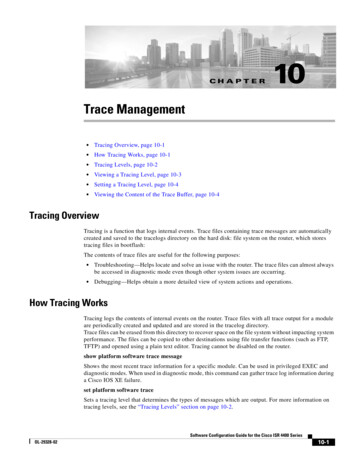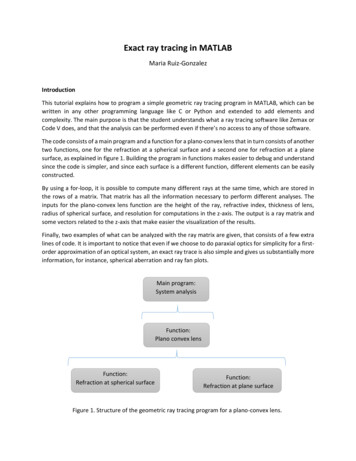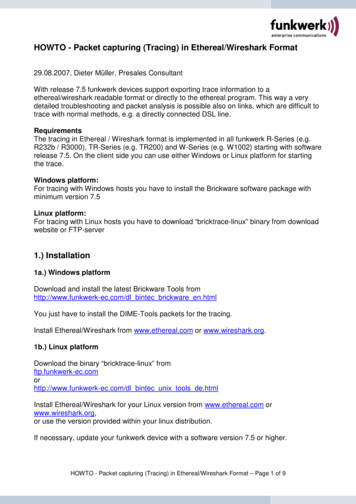
Transcription
Proceedings of the Asia-Pacific Advanced Network 2013 v. 36, p. 32-40.http://dx.doi.org/10.7125/APAN.36.5ISSN 2227-3026The flow back tracing and DDoS defense mechanism of theTWAREN defender cloudMing-Chang Liang 1, *, Meng-Jang Lin 2 , Li-Chi Ku 3 , Tsung-Han Lu 4 , Jyun-Jie Chen5and Ta-Yuan Chou6National Center for High-performance Computing / No. 28, Nan-Ke 3rd Rd., Hsin-Shi Dist.,Tainan City, Taiwan, R.O.C. 74147E-Mails: {liangmc, n00lmj00, lku, kileleu, jjchen, 1203053}@narlabs.org.tw* Tel.: 886-6-5050940#724; Fax: 886-6-5055909Abstract: The TWAREN Defender Cloud is a distributed filter platform on thenetwork backbone to help defending our connecting institutions against maliciousnetwork attacks. By combining the security reports from participating schools, thissystem can block the incoming threats from the entry points, thus it helps protectingall connecting institutions in the most economic and effective way. This paper aimedat explaining the analyzer design, its mechanism to back trace DDoS attack flows totheir entry points and the defense mechanism it provides to block the threats.Keywords: cloud computing; distributed processing; information security; backbonedefending; flow back tracing; TWAREN.1. IntroductionThe network security issue becomes increasing more prominent over time. While mostuniversities and research institutions tend to buy their own security equipment to defend theirnetwork, the equipment capable of handling high network bandwidth could be very expensiveand unaffordable to many schools. Furthermore, these independent defense mechanisms are hardto integrate and collaborate without intensive human intervention. Obviously it will be veryvaluable if these individual efforts can be integrated to become an overall protection mechanismto protect every institution on the network.To realize the idea, we designed the TWAREN Defender Cloud, shown as a diagram in figure1. The TWAREN Defender Cloud is a distributed platform which collects security reports and32
flow records from the backbone and connecting institutions and then reacts to security threats byanalyzing and blocking them from the backbone. Since TWAREN[1] has deployed networkequipment in all GigaPOPs, we are able to collect the flow data all over the backbone network.In addition, if schools and connecting institutions are willing to provide their flow data to us, theintegrated information can cover almost the entire country. Once a malicious activity is detectedand reported from any security detection device within this giant network, the IP and portinformation of the malicious activity can be immediately analyzed and used to inspect the entirebackbone flows to discover other victims or other malicious origins of the same attack. Then theadministrators can be notified and malicious flows blocked accordingly. Such defense is onlypossible from the backbone perspective because any individual security device in the schoolsdoes not have the overall information about the malicious activity. Furthermore, DDoS attacksusually fake their source IP, thus only a backbone defense mechanism can back trace the DDoSflows to their true entry points to the backbone and block them from there. By protecting thebackbone in this integrated way, other connecting institutions without their own securityequipment can also get benefit. Thus the backbone defense mechanism is very economic andeffective.Figure 1. The backbone view of the Defender Cloud.In order to handle the huge amount of backbone flow information, a highly scalabledistributed filter platform has been designed and implemented as shown in figure 2. The filterswere designed to compare flows against blacklists in a very high speed and only those targetedflows are sent to the backend analyzer to significantly reduce the loading and processing time ofthe analyzer. The result has been published in the Network Research Workshop in APAN32[2].33
Figure 2. The architecture of the TWAREN backbone defender cloud.Due to the distributed design of the TWAREN Defender Cloud and the use of UDP toexchange flow records among different modules, the components of the TWAREN DefenderCloud are highly modular and scalable, as shown in figure 3. In addition, incorporating externalanalyzers into the system will be very easy, thus the platform itself can serve as a collaborativeenvironment for external researchers to study the real world network threats. Of course, the flowdata will be transformed in prior to protect the user privacy.Figure 3. The main components of the defender cloud.34
Besides, we designed a module to automatically import the security reports from securityequipment and then integrate them into comparison rules. To further reduce unnecessary alarms,the module has been designed to make the comparison rules compact by sorting the securityreports according to their frequency, total number and impact. The result has been published inAPAN34[3].Figure 4. The generation of the comparison rules.As shown in figure 4, there are three main sources of the comparison rules. The first one isfrom the integration of security reports from security equipment. The second comes from thefreely available C&C data and the third one from the manually input rules, which is mainly usedto protect specific servers. After sending the rules to the filters, the comparison trees will beautomatically built and maintained, as shown in figure 5.Figure 5. Comparison rules shown in the Defender management system.35
After the completion of the filter and rule importing frontend, we shifted our focus to thedevelopment of the analyzer. As the backbone defender, DDoS attacks are our first priority todeal with because they are hard to defend within individual schools. DDoS attacks usually comefrom a lot of places and their source IPs are usually fake. From the perspective of securityequipment in schools, due to the lake of the overall scope, the only thing they can do is topassively block those known attack flows. Meanwhile, from the backbone perspective, thoseDDoS flows can be back traced to their origins. Whether they come from peer networks orconnecting institutions, we can notify their administrators to help stop the attack or check theinfected computers. Thus the TWAREN Defender Cloud can help a lot from its backbonestanding point once the DDoS analyzer is developed.2. Issues and MethodsEach flow record only contains the information of the incoming and outgoing port numberswhen the flow passes through any individual router. Therefore, in order to determine the full pathof the flow and the true origin of a DOS attack, a mechanism to discover the topology of thewhole backbone network will be necessary. In this section we explains the issues we faced andthe solution we designed during the development of the DDoS flow analyzer and the defensemechanism.2.1.The flow back tracing analysisThe DDoS analyzer needs to know the source routers of each flow records before these partialinformation can be assembled into the full path of the flow. However the header and the payloadof the flow record do not contain the IP of the router, thus the origin of the flow record can onlybe identified by the source IP of the UDP datagram in which the flow record is sent in the firstplace. Unfortunately, this information is no longer intact when the analyzer finally receives them,because the flow records need to be processed by the dispatcher and the filter beforehand.There are two possible ways to keep the IP of the source router somewhere in the flow records:the first possibility is to keep (overwrite) it in the last four bytes of the flow header, originallyrepresenting the Engine Type, Engine ID and Sampling Interval, which are not useful fornetwork security. The second possible way is to keep (rewrite) it in the source IP field of theflow record datagram, as if the packet is sent directly from its very source router. Because thefirst way would makes the flow header incompatible to industrial standard, thus limiting ourpossible collaboration with the academic researchers, the second way is therefore favored.The Defender Cloud back traces DDoS attacks from the victim, therefore all suspicious flowssending from the filters to the DDoS analyzers have the same (the victim) IP as their destinationIP. Starting with this IP, the full path of the attack flow is then constructed by assembling theflow records sending from all routers along the path. Due to their belonging to the same flow, all36
these flow records share the same source and destination IP, with the only difference being therespective incoming and outgoing router interfaces, which are denoting by their SNMP indexnumber. By inspecting the Next Hop field of the flow, the full path of the flow can be backtraced by looking up the source IP of the flow datagram (which is the IP of the source router) andthe interface SNMP index against the interface address database. As a consequence, the interfaceaddress database, which actually represents the full layer-3 topology of the backbone, needs to beestablished in prior.Because TWAREN is a hybrid network, rather than wiring directly with each other, therouters may be interconnected by optical light-paths, layer-2 Ethernet switches or VPLS-VPNswitches. While the physical topology can be obtained from our network management system, itis far too complex for the purpose of flow back tracing. Therefore we modified the networkmanagement system to produce a layer-3 only topology database. By extracting the runningconfig of all routers, the IPs of all router interfaces are obtained and then those belonging to thesame subnet are grouped together. Eventually the layer-3 relationship among all routers will beconstructed.However, the pure layer-3 information is not necessarily enough to represent the networktopology. For example, rather than 1:1 wiring, multiple routers may be connected by a VLAN orVPLS-VPN, and sometimes some of these routers do not have IP configured on their interfaces.Thus extra layer-2 information is necessary to fill the gap and make the topology informationuseful. The SNMP MIB for link neighbor discovery, such as the Cisco Discovery Protocol (CDP)and Juniper Neighbor Discovery Protocol, is used to identify the topology relationship when theinterfaces do not have IP configured.Taking equipment capable of running Cisco CDP as an example, the three MIBs listed in thetable 1 will be used.Table 1. MIBs for Cisco CDP capable equipment.MIB 1.2.1.1.61.3.6.1.4.1.9.9.23.1.2.1.1.7Object PortThe "cdpInterfaceName" stands for the interface name of the query machine,"cdpCacheDeviceId" shows the name of the neighbor device and "cdpCacheDevicePort" meansthe interface name of the neighbor device which directly connects to the query machine. Forexample, when we query the "cdpCacheDeviceId" MIB from a router, the returning result maylook 35 STRING: 3.1.2.1.1.6.53.124 STRING: .1.2.1.1.6.54.169 STRING: 23.1.2.1.1.6.58.164 STRING: "HC7609-1A.twaren.net"37
SNMPv2-SMI::enterprises.9.9.23.1.2.1.1.6.59.165 STRING: "HC7609-1A.twaren.net"The MIB values in the previous example shows the device names of the neighbor devices.And the numbers right after the string "enterprises.9.9.23.1.2.1.1.6." represent the index numberof the CDP interface of the query machine. In the example, they are 49, 53, 54, 58 and 59. If wequery the MIB values of the "cdpCacheDevicePort", it 135 STRING: .23.1.2.1.1.7.53.124 STRING: 1.7.54.169 STRING: .1.2.1.1.7.58.164 STRING: .1.2.1.1.7.59.165 STRING: "GigabitEthernet2/3"The numbers behind "enterprises.9.9.23.1.2.1.1.7." are also the index number of the CDPinterface of the query machine, which tightly correspond to the result of the "cdpCacheDeviceId"query. If we query the "cdpInterfaceName", the result looks like:SNMPv2-SMI::enterprises.9.9.23.1.1.1.1.6.49 STRING: .1.1.1.1.6.53 STRING: .1.1.1.1.6.54 STRING: .1.1.1.1.6.58 STRING: 3.1.1.1.1.6.59 STRING: "GigabitEthernet2/11"Using the interface index as the key to join the three query results, the layer-2 relationship ofthose connected devices can be discovered. For example, using the interface index 49 to join thequery results, we know that the interface GigabitEthernet2/1 of the query machine has a directlayer-2 connection to the GigabitEthernet1/0/25 of the neighbor "HC-3750P.twaren.net".After the layer-3 information assembly and the layer-2 neighbor discovery, the input interfaceof each flow record will be able to chain to the output interface of previous hop router and theoutput interface to the next hop router. Consequently the full path of the flow can be constructed.The two edge devices and interfaces are especially important and will be used in the defensemechanism against the DDoS attack.2.2.Defense mechanismBecause DDoS attack usually comes from a large number of zombie computers (Bot),blocking all of them by adding a lot of access control lists (ACL) to routers can severelyundermine the router performance. Instead of attempting to completely block the DDoS flows,our defense mechanism is designed to mitigate it by finding out those source routers havinglargest incoming DDoS impact and only blocking them there.Firstly, every DDoS flows are back traced from the victim IP to their corresponding origins,with all involved nodes and links along the flow paths being separately counted. For those nodesand links being passed more times by different DDoS flows, they get higher counting, whichmeans that they have higher impact than other nodes and links in this attack, as shown in figure6.38
Figure 6. Impact counting of the DDoS defense.Secondly, all those incoming edge routers having the counter value greater than a thresholdwill receive a command from the network management system to enlist an ACL to carry out theblock operation. Therefore the impact of the DDoS attack can be greatly reduced.Because the DDoS bots may change over time, the high impact edge routers may have tochange as a consequence. Thus the counters will be reset after a certain period of time.Meanwhile the ACLs will be tracked to avoid duplication and eventually be expired after apredefined time in order not to influence the router performance.In practice, although the defense mechanism can be fully automatic, there are still someissues. If the ACLs are implemented against the source IPs of the DDoS origins, the mechanismitself will be effective and precise, but due to the fact that most DDoS source IPs are fake, it maygenerate a large number of ACLs as a result, thus causing a significant burden to the backbonerouters. On the other hand, if the ACLs target the destination (victim) IP and port, only one or afew ACLs are needed. While the extra burden is minimal or even marginal, it may block legalflows at the same time, causing false positive problem. To overcome this dilemma, we still needmore DDoS experience and data to fine tune our defense mechanism design.Another issue of the automatic defense is that the connecting institution may not want theirnetwork flows being artificially filtered without their explicit consent. In order to solve this issue,a web system needs to be implemented to allow the connecting institution to manually activatethe DDoS defense mechanism against their selected flows.We consider inviting all connecting institutions to help improving the system by notifying theTWAREN NOC about their DDoS incidents. By investigating the DDoS flow history, oursystem can be further enhanced.3. Conclusions and Future WorkAfter finish developing the filter module and the rule import module, we shifted our mainfocus on developing the analyzer module of the TWAREN defender cloud. By collecting thelayer-3 interface IP information and the layer-2 neighbor discovery SNMP MIB data, thetopology of the network can be constructed. The full path of any flow can then be chained by39
joining flow records against the topology database, thus making the back tracing of the DDoSflows to their entrance possible. By accumulating and resetting counters on the network nodesand links along each flow, the edge routers can be sorted according to their impact to a givenDDoS attack. ACLs can be installed on those high impact edge routers to help mitigating theDDoS impact to the victims.References1.2.3.TaiWan Advanced Research and Education Network. (http://www.twaren.net/).Ming-Chang Liang; Hui-Min Tseng; Shin-Ruey Hsieh; Wei-Jie Liau; Jyun-Jie Chen; TeLung Liu; Jee-Gong Chang. The Design and Implementation of the Defender Cloud onTWAREN Backbone. APAN 32th Fall Meeting at New Delhi, India, 2011.Ming-Chang Liang, Meng-Jang Lin, Pin-Hsuan Chen, Shin-Ruey Hsieh, Jyun-Jie Chen,Tsung-Han Lu. The modular architecture of the TWAREN backbone defender cloud. APAN34th Fall Meeting at Colombo, Sri Lanka, 2012. 2013 by the authors; licensee Asia Pacific Advanced Network. This article is an open-accessarticle distributed under the terms and conditions of the Creative Commons Attribution /).40
The flow back tracing and DDoS defense mechanism of the TWAREN defender cloud Ming-Chang Liang 1,*, Meng-Jang . valuable if these individual efforts can be integrated to become an overall protection mechanism to protect every institution on the network. To realize the idea, we designed the TWAREN Defender Cloud, shown as a diagram in figure 1. The TWAREN Defender Cloud is a distributed .










